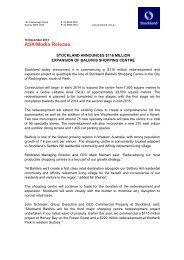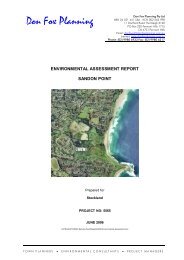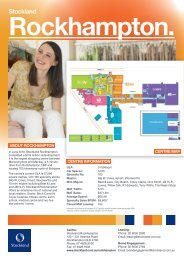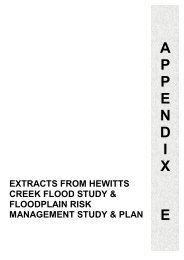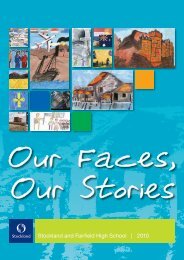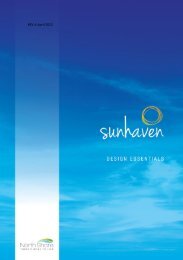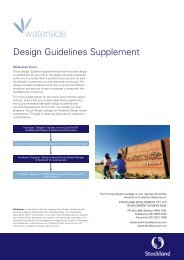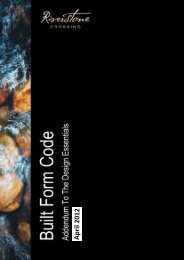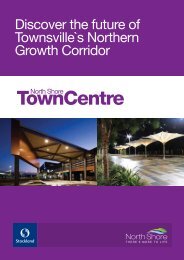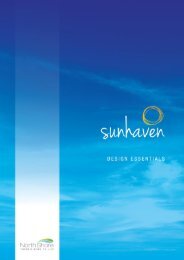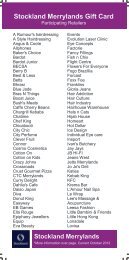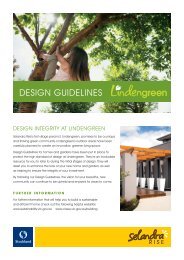Download PDF - Stockland
Download PDF - Stockland
Download PDF - Stockland
You also want an ePaper? Increase the reach of your titles
YUMPU automatically turns print PDFs into web optimized ePapers that Google loves.
CASE STUDY<br />
Building better community relationships – Sandon Point<br />
Sandon Point, NSW<br />
In November 2009, we were granted<br />
development approval to create a beachside<br />
residential community at McCauley’s Beach,<br />
Thirroul in New South Wales. We aim to<br />
provide the community with a quality modern<br />
development that respects and highlights the<br />
area’s Indigenous heritage, while protecting<br />
and enhancing the local character and<br />
environment. The project will comprise<br />
a north and a south precinct including:<br />
• Four phased villages, including 167 single<br />
dwellings and 14 town houses,<br />
• Rehabilitation of Hewitts, Woodlands<br />
and Tramway creeks, with native<br />
vegetation completing almost<br />
nine hectares of green open spaces.<br />
This will result in over one-third of the site<br />
being transferred to public ownership.<br />
Since we acquired the landholdings in<br />
1999, the undertaking of the project has,<br />
at times, led to strained relationships with<br />
some members of the local community.<br />
We understand the contested history<br />
around development at McCauley’s Beach<br />
and we recognise the need to make a<br />
renewed effort to build better relationships<br />
with the local community.<br />
The key areas of concern for our<br />
stakeholders are Indigenous and<br />
European heritage, climate change<br />
and the environment.<br />
Indigenous and European Heritage<br />
There are a number of Indigenous<br />
groups who have identified the area<br />
as their country. The New South Wales<br />
Government gazetted a section of coastal<br />
land at Sandon Point as an Aboriginal<br />
Place to preserve the significant area as<br />
open space. This preserved area is not<br />
on our development site.<br />
There is a possibility that some Aboriginal<br />
artefacts may exist on McCauley’s Beach<br />
and investigations into any artefacts found<br />
will be undertaken with the participation<br />
of representatives of the Aboriginal<br />
community and the Department of<br />
Environment, Climate Change and Water.<br />
We are exploring a range of proposals to<br />
acknowledge and celebrate the heritage<br />
of the locality, such as building a viewing<br />
platform on McCauley’s Beach which will<br />
provide information on the cultural history<br />
of the area.<br />
Climate Change and Environment<br />
In 2007 the concept plan approval for the<br />
development was revoked by the Land<br />
and Environment Court which ruled that<br />
the consideration of the impacts of climate<br />
change was inadequate. In response<br />
to these claims we undertook detailed<br />
climate change and flooding assessments.<br />
Studies of the ‘100 year flood’ show that<br />
the residential development is not at risk<br />
of possible ocean rise as a result of climate<br />
change. Our creek design will also ensure<br />
that all housing lots are above the one in<br />
100 year flood level, as adjusted for climate<br />
change predictions.<br />
The development will also see the restoration<br />
of three riparian corridors. Water-sensitive<br />
urban design will be incorporated as part of<br />
the creek design, to ensure that only clean<br />
water runs downstream.<br />
Community Engagement<br />
Our reputation has suffered, at times<br />
unfairly, over the course of the project.<br />
We have learned valuable lessons about<br />
the importance of proactive stakeholder<br />
engagement and are committed to<br />
listening and responding to local residents,<br />
Indigenous groups and our other<br />
stakeholders. As such, we have established:<br />
• A dedicated project website<br />
which provides stakeholders with<br />
regular updates and an avenue to<br />
submit feedback,<br />
• An Information Centre where the<br />
community can talk to the project team<br />
and view information, including plans,<br />
• Community information sessions to<br />
provide one-on-one contact with<br />
the project team,<br />
• A freecall information line so that<br />
enquiries can be responded to quickly<br />
and effectively,<br />
• Regular newsletters which provide<br />
up-to-date information about the project,<br />
• Notification letters to alert local<br />
residents of upcoming project works<br />
that may affect them.<br />
Since we reported on this project in our<br />
CR&S report 2008, we have implemented<br />
stakeholder engagement plans across<br />
100 per cent of our projects and operations.<br />
<strong>Stockland</strong> Corporate Responsibility & Sustainability Report June 2010<br />
25



